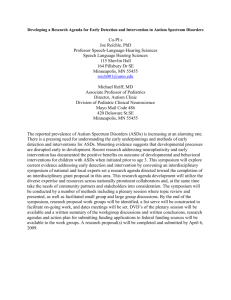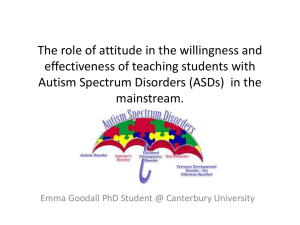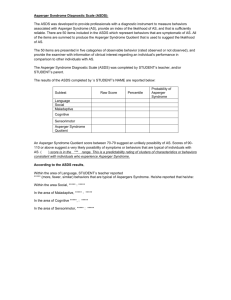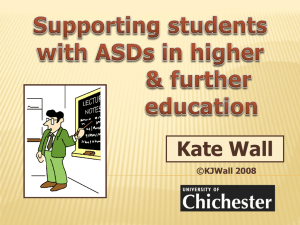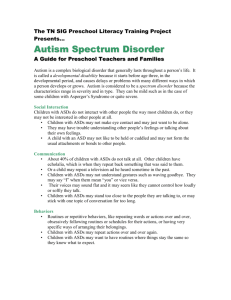ASD Pilot Programpptx
advertisement
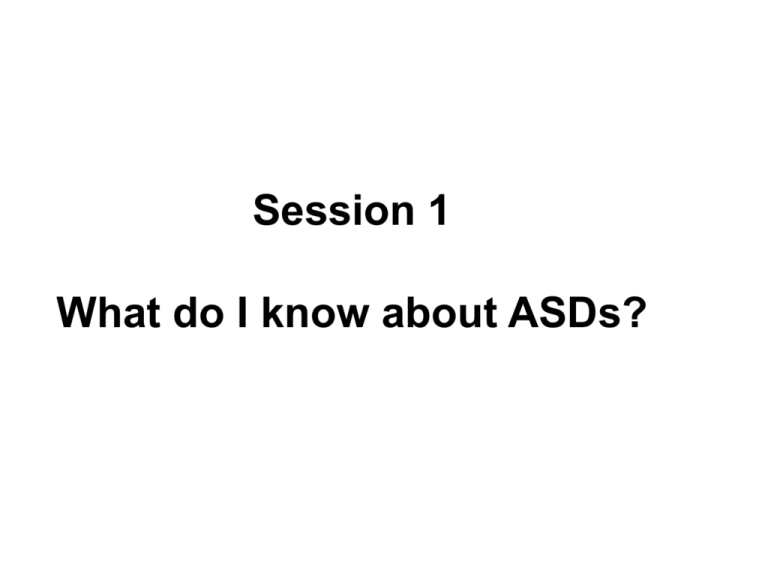
Session 1 What do I know about ASDs? Pervasive Developmental Disorders Autism Spectrum Disorders Rett Syndrome Autistic Disorder PDD-NOS Asperger Syndrome Childhood Disintegrative Disorder The term Autism Spectrum Disorders is used synonymously with the term autism The Diversity of Autism Communication COMMUNICATION SocialSOCIAL Interaction INTERACTION aloof Repetitive behaviour Restricted interest mild Sensory SENSORY I.Q Style Learning Intellectual Ability Learning styles (IQ) verbal non-verbal passive active/odd marked hyposensitive hypersensitive strong visual spatial skills; visual learner; kinaesthetic; gestalt learner; poor executive functioning; detail-focused severe moderate mild average gifted What do you know about ASDs? What do you see in your students? • communication • social • repetitive behaviours and restricted interests • sensory • information processing What are the implications of ASDs on learning and participation? Planning matrix Communication Characteristics Implications Strategies Social RI/RB Sensory Information processing What are the key issues for students with an ASD? Development of communication skills and systems • • • • • • • • Communication impacts on most areas of development. Impairments in receptive language. Literal/concrete understanding in AS/HFA echolalia (immediate, delayed, mitigated) difficulties initiating and sustaining communicative interaction differences between use of comments and requests (use of language) differences in eye gaze, body language and use of gesture to communicate unusual vocal quality and prosodic patterns What are the key issues for students with an ASD? Development of social connections • Social deficit the core feature of ASDs. • Students typically have fewer friends and may prefer the company of older or younger students • Some students may isolate themselves by choice. • Others may be aware of friendships and want friends but be perceived as irritating or intrusive. • May have very different interests and priorities to other students, causing further isolation. • Social skills issues – greeting, turn-taking, appropriate use of language, empathy. (Attwood, 2007) What are the key issues for students with an ASD? Repetitive behaviour & restricted interests • • • • • • • • • adherence to routines difficulty with change anxiety in unfamiliar situations interests or obsessions need to maintain a particular interest or routine behaviour relationships need for sameness chunk learning style What are the key issues for students with ASDs? Sensory-processing issues • two broad categories of sensory-processing issues – over-sensitivity and under-sensitivity and each sense has a different threshold • sensory-processing issues may impact significantly on behaviour • may contribute to the development or maintenance of anxiety disorders • may impact on the development of some communication skills • sensory-processing disorders may play a role in social interaction difficulties What are the key issues for students with ASDs? Information processing • attention to detail – failure to see the ‘big picture’ • generalising • recognising relevant detail • organisation and sequencing • social relationships • attention What do we know works for students with ASDs? Planning matrix Communication Characteristics Implications Strategies Social RI/RB Sensory Information processing What do we know works for students with ASDs? Communication • providing opportunities for communication • encouraging and teaching initiation • providing communication supports AND teaching how to use • supporting receptive language visually What do we know works for students with ASDs? Communication supports for expressive communication • known as Augmentative and Alternative Communication (AAC) • the use of other forms of communication (e.g. pictures, gestures, signing or voice output) to support speech • may be high tech or low tech, aided or unaided • where available, can be supported by a speech pathologist What do we know works for students with ASDs? Supporting language visually Visual supports can be used to help a student: • understand an instruction • understand routines and structure • cope with transitions • learn how to play • cope with change • learn new skills • manage their behaviour and understand what is expected of them What do we know works for students with ASDs? Positive Behaviour Support (PBS) Proactive strategies • an ‘A-B-C’ approach – finding out the function of the behaviour • environmental changes – managing antecedents • teaching replacement behaviours • positive reinforcement Reactive strategies PBS will be covered in detail in module 3 What do we know works for students with ASDs? Sensory Processing Issues • • • • sensory profiling adapting the environment addressing seeking behaviours addressing avoidance behaviours NB: addressing sensory processing issues is not the same as ‘sensory integration’ What do we know works for students with ASDs? Friendships/making social connections • social skills training is not the only answer • not all students will desire social interaction • need to accommodate all students • consider the hidden curriculum What do we know works for students with ASDs? Bullying • limited research on effective strategies for students with ASDs • team approach needed to define bullying and determine consequences • broad definition of bullying needed – more than just physical injury • whole school strategies include buddy systems and codes of conduct • Attwood (2004) suggests students learn to avoid vulnerable situations • students can learn and practise responses • consider Social Stories™ and cartoon conversations using speech bubbles What do we know works for students with ASDs? Dealing with anxiety/mental health issues • limited research on treatment options, mostly on medication and psycho-analysis • cognitive behavioural therapy shown to be effective • environmental management and positive behaviour supports may assist What do we know works for students with ASDs? What can be done at school? • • • • utilise strengths and interests modify tasks if they are too difficult be aware of sensory stimuli and modify environment use visuals in the classroom to: - help student prepare for changes - help student learn the classroom routines - help student understand classroom social skills (e.g. how to ask a question, how to join a group) • education to help student recognise their ‘emotion warning signs’ and their ‘body clues’ Three types of adjustments Adjustments Curriculum Adapt what is taught Preference/ Interest Meaningful/ Functional Difficulty Instructional Adapt how it is taught and how learning is demonstrated Environmental Adapt the setting – where, when, and with whom Where Student Response Instructional Presentation Alternation Modality Format/Materials Task Division Choice Modality Format/Material When Who Florida’s PBS Project at USF website: http://flpbs.fmhi.usf.edu Adjustment matrix for the individual learner Comm Curricula Instructional Environmental Social RI/RB Sensory Info proc Three types of adjustments Adjustments Curriculum Instructional Environmental Adapt what is taught Adapt how it is taught and how learning is demonstrated Adapt the setting – where, when, and with whom Florida’s PBS Project at USF website: http://flpbs.fmhi.usf.edu Curriculum and instruction • curriculum provides a blueprint for learning which teachers can follow when designing instruction • curriculum helps an educator meet community, parental, and student expectations for quality in education Curriculum and instruction Helpful teaching questions: • What do I want my students to learn? • Do i need to make any adjustments at all? • Would technology help at all? • Do some students need material presented differently? • Should some students present their work differently? • Will all students be assessed in the same way? • Will some students need additional or different goals? Adapted from Shaddock et al. (2007). Lesson Guide Idea for staff organisation: use highlighters to colour-code areas that each member of class staff will be focusing on Which learning outcomes are you working towards? What are the indicators? Environmental supports What does it look like? Break down sequence of events. Communication Supports (Level of prompting?) Receptive Expressive Sensory supports What do you want your students to learn? Some * * * * Most * * * * All * * * * Behaviour & Social supports Three types of adjustments Adjustments Curriculum Instructional Environmental Adapt what is taught Adapt how it is taught and how learning is demonstrated Adapt the setting – where, when, and with whom Florida’s PBS Project at USF website: http://flpbs.fmhi.usf.edu Instructional strategies Examples – refer to Manitoba Educational handout, Chapter 4 Teaching the student with ASD • errorless learning • concrete examples/hands-on activities • generalisation training • peer tutoring/guidance • teacher assistants Social Scripts Am I in Control ? At school everybody has the right to feel safe. Teachers have the right to feel safe every day they come to school. Teachers prefer to work with students that respect themselves and each other and show that everyone has the right to feel safe. I have the right to come to school everyday and feel safe, and that people are going to respect me. Sometimes there are students that try to take away my right to be safe. These students tend to tease and bully other students. Some of these students are trying to tease and bully me into fighting with them. I have two choices; I can fight them or use my self control. If I fight them they will win, because I will get into trouble, and I will still be angry. Self control is when I make the choices that keep me safe. Self control means telling myself that I am a stronger person. Stronger people can ignore bullying and teasing, leaving the other student standing looking silly. Self control means reacting calmly or not at all. These students try to push my buttons and get me into trouble. If I can keep my self control and ignore them, I should avoid trouble. Taking deep breaths and keeping my ears closed, is a strong way to ignore others. Avoiding trouble, remaining calm and being able to get back to work, shows the teachers and other students at school that I respect myself and others right to feel safe. Language & communication supports Literal interpretation of language Raining cats and dogs Cats and dogs coming down from the sky Lots of rain Maths Year 8 - Mr. Waters 8 x (3+2) = _____ 4 – (6 + 5) = ____ 2 x (8 – 5) = _____ 9 ÷ (7 - 4) = _____ (2 + 4) x 8 = _____ (6 + 7) x 2 = _____ (6 – 3) x 4 = _____ 42 ÷ (9 – 3) = ____ 56 ÷ (11 – 4) = ____ 25 x (5 – 2) = ____ (4 + 5) ÷ 3 = _____ 25 ÷ (7 – 2) = ____ Maths Year 8 - Mr. Waters 7 x (25 – 13) = ____ 9 + 8 x 6 = ______ 8 x (3+2) = _____ 4 – (6 + 5) = ____ 2 x (8 – 5) = _____ 9 ÷ (7 - 4) = _____ (2 + 4) x 8 = _____ (2 + 4) x 8 = _____ (6 + 7) x 2 = _____ (6 + 7) x 2 = _____ (6 – 3) x 4 = _____ 42 ÷ (9 – 3) = ____ 56 ÷ (11 – 4) = ____ 25 x (5 – 2) = ____ (4 + 5) ÷ 3 = _____ 25 ÷ (7 – 2) = ____ 7 x (25 – 13) = ____ 9 + 8 x 6 = ______ Activity: Instructional Strategies Errorless Learning Regular (Mainstream) Classroom Special Education Classroom Concrete examples/hand s-on activities Generalisation Training Peer Tutoring/ Guidance Teacher Assistants Three types of adjustments Adjustments Curriculum Adapt what is taught Instructional Adapt how it is taught and how learning is demonstrated Environmental Adapt the setting – where, when, and with whom Florida’s PBS Project at USF website: http://flpbs.fmhi.usf.edu Environmental audit Some key points to consider: 1. the student’s expectations 2. the expectations of others in the setting 3. nature of the teaching materials, the activity, the type of instruction 4. length of task or activity, the nature of the activity just completed, the nature of the activity to follow 5. instructional style 6. opportunities for interaction with others 7. opportunities to engage in functional, chronologicallyage-appropriate activities Environmental audit (continued) 8. person’s physiological status 9. number of persons, students, adults in the learning environment 10. environmental constraints including the number of staff, time available, number of tasks 11. behaviour of others, for example the modelling behaviour they engage in and the behaviour directed toward student 12. recent changes in environment, sudden changes in activity, schedule, etc 13. distribution of interactions and relative distribution of positive vs. negative interactions Structuring the physical environment • organise areas according to the activity/curriculum to be delivered • a place for everything and everything in a place • mark out physical boundaries e.g. teacher’s area • communicate behavioural expectations (class rules) • review classroom stimuli that may have a distracting effect (refer to profile) • review classroom set up; proximity of desks, visual stimuli (posters, charts etc), pathways, mess and clutter factor To conclude - key adjustments include: • structured, routine & predictable environments • visual supports, scripts, written directions, social stories • task adaptation & modification of curriculum where possible • adjust adult expectations • use specific explanations; leave nothing unsaid or assumed • positive reinforcement • build on special interests, skills and abilities • environmental adjustments; reduce environmental & social stressors, especially and sensory What do you know about the Disability Standards for Education (2005)? • Disability Standards for Education came into effect in August 2005 • set out the rights of students with a disability in the area of education • set out the obligations for adult and community education providers that develop and accredit curricula and courses Students with HFA/AS are likely to: • have difficulty relating appropriately to others, forming and maintaining social relationships • be verbal but present with a wide range of language and communication disorders and peculiarities • have difficulty in successfully following and mastering interpersonal interaction and specific aspects of an unmodified curriculum • be good at attending to detail and have difficulty understanding the “big picture” Students with HFA/AS: (cont’d) • have difficulty generalising information (consider across subjects) • have difficulty organising and sequencing information • have powerful interests in particular topics and desire for sameness • have irregular educational and cognitive deficits which can include splinter skills • be subject to bullying and mental health issues Assets of AS/HFA • • • • • • • • memory factual learning strengths attention to detail skills in maths, science, computing areas specialised interests indifference to peer pressure rules-based refreshingly frank and logical Students with ASDs + ID may • be nonverbal or have little functional speech • have very limited social communication skills (difficulty relating to others) • have an obsessive interest in environmental sameness • demonstrate atypical and difficult to understand behaviour including stereotypic, repetitive and self stimulatory behaviour • have irregular educational and cognitive deficits which can include splinter skills • have difficulty generalising information (consider across contexts) • have difficulty organising, sequencing of information, understanding concepts • have significant sensory issues What do you know about the Disability Standards for Education (2005)? Focus points • enrolment • participation • curriculum development, accreditation and delivery • student support services • harassment and victimisation What do you know about the Disability Standards for Education (2005)? What are these obligations? • obligation to consult • obligation to make reasonable adjustments • obligation to eliminate harassment and victimisation What do you know about the Disability Standards for Education (2005)? • ‘on the same basis’ means treating the student with a disability on the same basis as the student without a disability • moderated by principle of ‘unjustifiable hardship’ • some students may require adjustments and accommodations What do you know about the Disability Standards for Education (2005)? Implications for educators and support staff All staff need to have the skills, knowledge and understanding to implement curriculum in a way that will be accessible to all students, including students with a disability What does ‘evidence-based’ practice mean? What does ‘evidence-based practice’ mean? • Evidence-based practice involves the conscientious and explicit use of current best evidence in making decisions about the care, education and medical treatment of an individual. ‘Am I doing the right thing in the right way with the right person at the right time in the right place for the right result – and am I the right person to be doing it? …and, is it at the right cost?’ (Cusick 2001, p103). What does ‘evidence-based practice’ mean? Levels of evidence Strongest • systematic review of all relevant randomised control trials • randomised, double-blind, placebo-controlled trial • cohort study • multiple-case study • single-case study • expert opinion • anecdotal/testimonial evidence Weakest What does ‘evidence-based practice’ mean? Be cautious if: – the research was done by the people who have designed the treatment approach – the research is by people that stand to profit from its success – researchers claim they can cure autism – the evidence relies heavily on anecdotal information or testimonials What does ‘evidence-based practice’ mean? Some tips: • be mindful of the quality of the facts and figures • check what any statistics mean and if any changes would be meaningful to a child with an ASD • popularity of an approach does not indicate an evidence base • check who participated in the research and if your child/student fits into this group (e.g. research into Autistic Disorder may not be applicable to children with Asperger syndrome) What works? Empirical evidence Recommended good practice in educational pedagogy for students with an ASD includes: • an individualised approach – developing a Learner Profile • the provision of an autism-specific curriculum* (targets characteristics of autism within the final curriculum) • a highly supportive teaching environment and uses a range of systematic teaching strategies • using a functional communication and positive behavioural approach to challenging behaviours • collaborative team approach that involves families and other professionals Roberts & Prior (2006) Ivanhoe, Dunlap, Huber & Kincaid (2003), Howlin (1998). What makes for a successful school placement? A positive school climate: • shared responsibility by general and special educators • school community ownership of the included student(s) with autism • access to collaborative problem-solving relationships, multidisciplinary teams • availability of appropriately trained support personnel • low staff-student ratios And … • home-school collaboration • the development of social skills for the student with autism in inclusive settings • availability of specialist training for all staff • adequate teacher planning time • recurrent evaluation of inclusion practices (Simpson et al., 2003) ASPERGER SYNDROME WEB SITES What is the biology of Asperger’s Disorder? http://www.unmed-edu/publo/ozbayrak/asperger.html On-line Asperger’s Syndrome Information and Support – O.A.S.I.S. http://www.udel.edu/bkirby/asperger/ ASPEN of America http://www.asperger.org/ University Students with autism and Asperger’s Syndrome http://www.users.dircon.co.uk./-cns/ Asperger’s Teenagers and Young Adults http://www.geocities.com/HotSprings/Spa/1864 Yale University http://info.med.yale.edu/chldstdy/autism/page10.html Asperger’s Syndrome Information Package http://www.autism-society.org/packages/aspergers.html Asperger’s Syndrome – educational management issues http://www.ozemail.com.au/~prussia/asperger/teach.htrn
